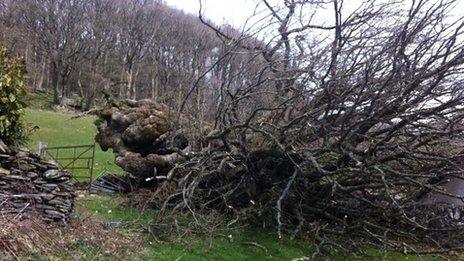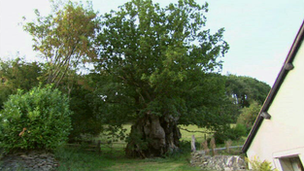Toppled Pontfadog Oak in Chirk could be cloned from DNA
- Published

The Pontfadog Oak was felled by winds of up to 60mph
A 1,200-year-old oak tree which was toppled by strong winds could be cloned after some of its twigs and buds were taken to try to create a genetic match.
Samples of the Pontfadog Oak have been sent to organisations, including the Royal Botanic Gardens in Kew, which will attempt to extract its DNA.
The tree, which was near Chirk, in Wrexham county, was reputed to be one of the UK's oldest and largest oaks.
If the DNA process works, the cloned tree could return to its original plot.
The tree had a girth of 42ft 5in (12.9m) with a huge hollow trunk big enough to seat six people at a table.
Legend has it that it was a rallying point for Welsh princes such as Owain Gwynedd, who is said to have met his troops under it in the 12th Century before defeating English king Henry II in battle.
But the sessile oak, which was still popular with walkers and visitors, was felled by gusts of up to 60mph overnight on 18 April after standing since 802.
'Phoenix from the ashes'
Wrexham council tree officer Moray Simpson decided to take samples from the tree in the hope it could be cloned.
He said its DNA was important not only because the tree was so significant culturally and historically, but also to preserve the "good genetics" of an ancient oak at a time when many trees were succumbing to disease.
Although the process of extracting the genetics could be very difficult, he hoped that, if successful, it could be like "a phoenix rising from the ashes".
"And wouldn't it be fantastic if in another 1,200 years time, the tree will still be stood there?" he added.
Mr Simpson has sent the twigs and buds to Kew, along with the Windsor Great Park estate, the National Trust and a tree expert in Cambridgeshire.
They will all try to graft the buds and twigs from the Pontfadog Oak onto the root stocks of other young oak trees.
It is hoped the trees will then fuse together and the Pontfadog Oak section of the tree will grow.

The Pontfadog Oak was said to have been a meeting point for Welsh princes many centuries ago
The Royal Botanical Gardens Kew could then take the new Pontfadog growth and try to get the exact genetic match of the tree - a process known as micro-propagation.
"If they do manage it, it would be the exact same genetics of the Pontfadog Oak," said Mr Simpson.
"The tree will be lost but the genetics won't be. The first cloned tree would hopefully go back to where the original one grew and we could put others around the Wrexham area."
'Iconic' tree
However, he warned that there was a long, uncertain road ahead.
"It will be at least a year before we know if the tree has grafted and that's before the micro-propagation," he said.
"I'm aware the whole process for oaks is very difficult and it's very late in the season to do it, but I couldn't just stand by and see its genetics lost.
"It was the most iconic tree in Wales. It was one of the oldest trees in Europe, which means one of the oldest in the world."
He added that acorns from oak trees were not genetic matches of the tree because they are wind pollinated trees, meaning the new saplings would have a mixture of genetics.
Rob McBride, who records old trees, said he was unaware of other ancient trees being cloned in Wales.
"I don't think it's ever been done for such a significant tree," he said.
He added that there were also a number of plans being put forward about what to do with the original fallen oak.
One includes resurrecting the tree at a spot close to where it originally stood.
- Published19 April 2013
- Published19 April 2013
- Published18 April 2013
- Published10 March 2012